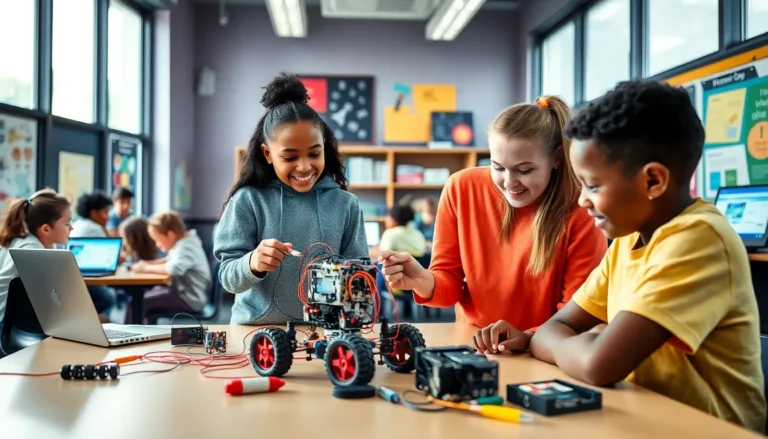Table of Contents
ToggleIn a world where kids are glued to screens, it’s time to unleash their inner Einsteins with STEM programs that make learning fun. Imagine your child building robots, coding their own video games, or conducting wild science experiments that could make even Bill Nye raise an eyebrow. STEM isn’t just a buzzword; it’s a gateway to creativity and critical thinking that prepares kids for the future.
Overview of STEM Programs for Kids
STEM programs engage children in hands-on activities that bolster their interest in science, technology, engineering, and mathematics. These programs play a vital role in developing skills that prepare kids for future opportunities.
Importance of STEM Education
STEM education encourages critical thinking and problem-solving abilities essential for success in today’s world. Kids who participate in STEM programs often develop resilience as they encounter challenges during projects. This education also fosters teamwork, allowing children to collaborate effectively. Involvement in STEM activities can increase engagement in school, as students discover real-world applications of their lessons. Studies show that early exposure to STEM concepts enhances children’s career aspirations and builds a strong foundation for lifelong learning.
Key Components of STEM Learning
Hands-on activities are crucial to effective STEM learning experiences. Engaging projects like coding, robotics, and engineering challenges facilitate active participation. Interdisciplinary approaches connect science, technology, engineering, and mathematics in meaningful ways. Real-world problem-solving tasks help students apply theoretical knowledge in practical situations. Integrating technology offers kids access to tools and resources that support innovation and creativity. Mentorship from experienced professionals can further inspire children to pursue STEM fields, creating pathways to future careers.
Types of STEM Programs
Various options exist to engage kids in STEM activities that enhance learning and skills. Each program type offers unique experiences that cater to different interests and schedules.
After-School Programs
After-school programs provide structured environments for children to explore STEM subjects further. Students engage in hands-on projects that stimulate curiosity. Activities often include robotics, coding, and interactive experiments. Such programs reinforce concepts learned during school hours while promoting teamwork and collaboration. Many schools partner with local organizations to enhance offerings, providing resources and mentorship to enrich learning experiences.
Summer Camps
Summer camps focus on immersive STEM education in a fun, informal setting. Camps typically run for several weeks and offer specialized themes like engineering, computer programming, and environmental science. Participants work on group projects that foster creativity and problem-solving. Outdoor activities often complement classroom experiences, connecting students with nature and technology. These camps sometimes culminate in presentations, showcasing the skills and knowledge gained over the course of the program.
Online Resources
Online resources deliver flexible STEM learning opportunities for children to explore at their own pace. Websites and platforms host a plethora of coding tutorials, science experiments, and virtual workshops. Interactive games encourage hands-on learning while providing a fun way to grasp complex concepts. Many resources are free or low-cost, making STEM education accessible. Parents often find that these tools enhance classroom learning and maintain children’s engagement in STEM during breaks or at home.
Benefits of STEM Programs for Kids
STEM programs provide numerous advantages that significantly impact children’s development.
Enhancing Problem-Solving Skills
Hands-on activities in STEM foster critical thinking and problem-solving skills. Engaging in projects that require devising solutions encourages a logical approach to challenges. For instance, building a robot necessitates troubleshooting when parts don’t function as expected. Through these experiences, children learn to analyze situations, evaluate outcomes, and adapt their strategies effectively. Participants often develop a persistence that helps them tackle complex problems in school and beyond.
Fostering Creativity and Innovation
STEM programs stimulate creativity by integrating science and technology with artistic expression. Kids can experiment with coding to create unique video games or design innovative science projects. This blend of disciplines inspires them to think outside the box and explore new ideas. For example, designing a video game not only involves computer skills but also narrative development and artwork. By balancing structure with freedom in their creations, children cultivate an innovative mindset that benefits future endeavors.
Encouraging Teamwork and Collaboration
Collaboration is a key element in STEM education, as many projects require teamwork. Working together on tasks fosters communication skills and shared responsibility among participants. Children learn to value differing perspectives and navigate conflicts during collaborative projects. For instance, developing a group science experiment teaches kids to delegate tasks while integrating everyone’s ideas. Such experiences reinforce the importance of cooperation, preparing them for professional environments where teamwork is essential.
Choosing the Right STEM Program
Selecting the appropriate STEM program involves assessing several key factors, ensuring the program matches a child’s interests and developmental needs.
Age Appropriateness
Evaluating age appropriateness of a STEM program is crucial. Programs designed for younger kids focus on fundamental principles through engaging activities, while those for older children delve into advanced concepts. Offering age-specific projects helps maintain interest and boosts confidence. For instance, robotics programs for ages 6 to 8 introduce basic programming through simple tasks, while programs for ages 12 and above cover intricate coding languages. Parents should ensure the chosen program aligns with their child’s cognitive abilities to maximize engagement and learning.
Program Structure and Curriculum
Examining program structure and curriculum reveals the quality and depth of STEM education. Effective programs incorporate hands-on activities that encourage exploration and creativity. A balanced curriculum includes various subjects that promote interdisciplinary connections, such as integrating math with science experiments. Programs should also have clear learning objectives and assessments to track progress. Those focused on real-world applications often provide valuable problem-solving experiences, enhancing critical thinking skills. Researching the program’s structure guarantees a comprehensive approach to learning.
Location and Accessibility
Considering location and accessibility of STEM programs influences participation. Programs located within schools, community centers, or online platforms ensure children can easily access resources. Local options often provide in-person interaction with peers, fostering teamwork and collaboration. Alternatively, online resources grant flexibility, allowing children to learn at their own pace from home. Assessing transportation options helps determine feasibility for after-school activities and summer camps. Availability and ease of access directly impact a child’s ability to engage in STEM learning opportunities.
STEM programs for kids are more than just educational tools; they’re gateways to a world of creativity and innovation. By engaging in hands-on activities and collaborative projects, children not only develop critical thinking skills but also learn to navigate real-world challenges. With a variety of options available, from after-school programs to online resources, parents can find the right fit to spark their child’s interest in science, technology, engineering, and mathematics. Investing in these programs lays a strong foundation for their future, encouraging a lifelong love for learning and exploration in STEM fields.







